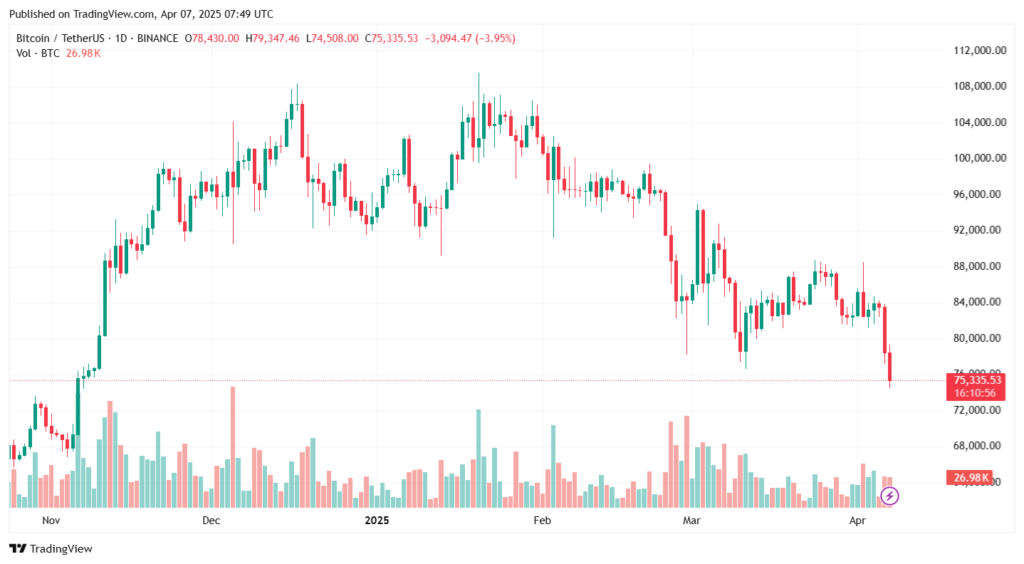– Ad –
| Getting your Trinity Audio player ready... |
In April 2025, the cryptocurrency market witnessed one of its worst meltdowns in history. Over $1.3 trillion in market value was wiped out within days, sending shockwaves through the digital economy and financial markets around the world.
The crash began as a sharp decline in Bitcoin and Ethereum, but it quickly spread across altcoins and DeFi tokens. Millions of retail investors and institutional players saw their portfolios shrink overnight. Major exchanges experienced record-high traffic as panic set in, triggering widespread sell-offs, liquidations, and market uncertainty.
This event wasn’t just a technical glitch or a mild correction. It was a systemic shock fueled by global politics, economic fears, and high-risk trading behavior—all culminating in a digital bloodbath.
The Spark: Escalating Trade War & Tariff Tensions
At the heart of the April 2025 crypto crash was a geopolitical powder keg: escalating tariff tensions between the United States and its major trading partners.
On April 2, 2025, former President Donald Trump announced sweeping new tariffs—10% across all imports and higher rates for trade surplus countries. While aimed at protecting U.S. manufacturing, the move sparked global panic. Financial markets reacted swiftly, with stock futures plunging and investor sentiment turning decidedly negative. The ripple effect was immediate and brutal, particularly in high-risk assets like cryptocurrencies.
Stocks dipped, currencies stumbled, and commodities like oil and gold surged. But the crypto market, often touted as “digital gold,” didn’t act as a safe haven. Instead, it reacted with fear and flight, especially from investors who had overexposed themselves to leverage.
Key points that accelerated the panic:
- China, the EU, and Canada all responded with counter-tariffs, deepening fears of a full-scale trade war.
- Institutional investors began unwinding positions in high-volatility assets—including crypto.
- Safe-haven flows moved toward the U.S. dollar and treasury bonds, not Bitcoin or Ethereum.
These global ripples created a perfect storm that rapidly engulfed the digital asset space.
The Data: A Breakdown of the Collapse
To fully grasp the impact, let’s look at how major cryptocurrencies performed during this crash:
| Cryptocurrency | Price (April 1) | Price (April 7) | % Drop |
| Bitcoin (BTC) | $88,000 | $74,857 | -14.9% |
| Ethereum (ETH) | $1,800 | $1,446.77 | -19.6% |
| BNB (BNB) | $590 | $530.32 | -10.1% |
| XRP (XRP) | $2.10 | $1.68 | -20.0% |
| Cardano (ADA) | $0.64 | $0.52077 | -18.6% |
The data comparing prices from April 1 to April 7, 2025, highlights the sheer magnitude and speed of the downturn that hit the cryptocurrency market. Within just one week, all major cryptocurrencies saw double-digit percentage losses, contributing to the staggering $1.3 trillion market wipeout.
Here’s a breakdown of what the table reveals:
- Bitcoin (BTC), the market leader, dropped nearly 15%, falling from $88,000 to just under $75,000. This sharp decline from such a high base triggered alarm bells for investors globally and acted as a signal for a broader market retreat.
- Ethereum (ETH) was even more severely affected, shedding 19.6% of its value. As a platform that underpins countless DeFi and NFT projects, Ethereum’s sharp fall had ripple effects across the entire blockchain ecosystem.
- BNB (BNB), although less volatile, still declined by over 10%, signaling that even the more resilient coins couldn’t withstand the market-wide pressure.
- XRP and Cardano, popular among both retail and institutional investors, saw steep declines of 20% and 18.6%, respectively. This reflects heightened selling pressure in altcoins, which are often the first to suffer during high-volatility periods.

These drops weren’t gradual corrections. They occurred during a brief window when fear overtook fundamentals, and panic selling became widespread. Notably, April 2–5 saw the sharpest moves, aligning precisely with the announcement of new tariffs and mounting global trade tensions.
The data underscores a crucial truth about crypto markets: they remain highly sensitive to macroeconomic developments, and leverage amplifies both the highs and the lows. For investors, this table is a sobering reminder of the risks—and potential rewards—inherent in digital assets.
Leverage, Liquidations & Fear
One of the most powerful accelerants of the crash was leverage.
Over the past year, traders had been increasingly using margin accounts to boost gains. But what goes up fast can come down even faster. As crypto prices dipped, margin calls began triggering automatic liquidations.
Within a 48-hour window:
- Over $1.3 trillion in long positions were liquidated.
- Major exchanges like Binance, OKX, and BitMEX saw record trading volume and outage warnings.
- Social media was flooded with reports of wiped-out accounts and sleepless traders.
Fear spread like wildfire. Market sentiment, tracked by the Crypto Fear & Greed Index, plummeted from Neutral (50) to Extreme Fear (10) overnight.
Retail investors, already jittery from 2022’s and 2023’s price fluctuations, panic sold en masse, contributing to a self-reinforcing downtrend.
Is This a Correction or a Crash?
The big question many are asking: Was this just a correction, or something more serious?
Arguments for a Correction:
- Crypto markets had been overbought since late 2024.
- Prices were riding high without strong fundamentals for many altcoins.
- This could be a healthy recalibration.
Arguments for a Crash:
- Losses were too steep and too fast, akin to previous bubble bursts.
- External macroeconomic forces (like trade wars and inflation) are still looming threats.
- Confidence in decentralized finance (DeFi) and stablecoins took a hit.
Most experts agree it’s too early to tell. While some coins have begun to stabilize, the broader market remains fragile.
What Happens Next?
As markets seek clarity, investors and analysts are watching several critical indicators:
1. Regulatory Response
Will U.S. regulators tighten crypto laws in response to the volatility? Or will they take a hands-off approach to avoid stifling innovation?
2. Trade Developments
If global leaders escalate tariff measures, risk assets like crypto may continue to suffer. A resolution or de-escalation could restore investor confidence.
3. Market Sentiment
Platforms like Glassnode and Santiment are tracking wallet activity, funding rates, and new address creation—all clues to future direction.
4. Institutional Moves
Will big players like BlackRock, Fidelity, or Tesla buy the dip? Or will they reduce their exposure?
For retail investors, patience and prudence are key. Diversifying across assets and maintaining proper risk controls can help navigate this storm.
Also Read: Trump’s Strategic Bitcoin Reserve: A Game-Changer or a Risky Move?
Final Thoughts
The April 2025 crypto crash was more than a market correction—it was a stress test of confidence in decentralized finance. Driven by geopolitical chaos, economic anxiety, and unchecked leverage, the crash highlights the need for smarter trading habits and deeper resilience in the system.
Whether it becomes a historic turning point or just another chapter in crypto’s wild ride depends on what happens next—both in markets and policy arenas. One thing is certain: crypto isn’t going anywhere, and neither is the volatility that defines it.
FAQs
What caused the April 2025 crypto crash?
A mix of Donald Trump’s tariff announcement, global trade tensions, high leverage, and mass liquidations triggered the crash.
How much value was lost during the crash?
Over $1.3 trillion in crypto market value was wiped out in just a few days.
Is this the start of a bear market?
It’s uncertain. Some experts view it as a necessary correction, while others see signs of a prolonged downturn.
Were any cryptocurrencies safe during the crash?
Very few. Even stablecoins showed volatility, and nearly all major coins suffered double-digit losses.
What should investors do now?
Reassess portfolios, avoid panic selling, and watch for regulatory and global economic updates.
Can crypto recover from this?
Historically, yes. Crypto has survived several major crashes and often emerged stronger, though recovery timelines vary.

















